
What do the numbers mean? A survey is administered by a marketing firm. Two of the people surveyed are Brenda and Jason. Three of the questions are as follows:
- Do you favor the construction of a new shopping mall?
- How many cars do you own?
- What is your marital slams?
(1) Strongly oppose (2) Somewhat oppose (3) Neutral (4) Somewhat favor (5) Strongly favor
(1) Married (2) Single (3) Divorced (4) Domestically partnered (5) Other
- Are the responses for question (i) nominal or ordinal?
- On question (i), Brenda answers (2) and Jason answers (4). Jason’s answer (4) is greater than Brenda’s answer (2). Does Jason’s answer reflect more of something?
- Jason’s answer to question (i) is twice as large as Brenda’s answer. Does Jason’s answer reflect twice as much of something? Explain.
- Are the responses for question (ii) qualitative or quantitative?
- On question (ii). Brenda answers 2 and Jason answers 1. Does Brenda’s answer reflect more of something? Does Brenda’s answer reflect twice as much of something? Explain.
- Are the responses for question (iii) nominal or ordinal?
- On question (iii). Brenda answers (4) and Jason answers (2). Does Brenda’s answer reflect more of something? Does Brenda’s answer reflect twice as much of something? Explain.
a.
To identify:whether the responses for question (i) nominal or ordinal.
Answer to Problem 49E
The responses for question (i): ordinal.
Explanation of Solution
Given information:A survey is administered by a marketing firm. Two of the people surveyed are Brenda and Jason. Three of the questions are as follows:
Do you favor the construction of a new shopping mall?
(1) Strongly oppose (2) Somewhat oppose (3) Neutral (4) Somewhat favor (5) Strongly favor
ii. How many cars do you own?
iii. What is your marital status?
(1) Married (2) Single (3) Divorced (4) Domestically partnered (5) Other
Concept Involved:
There are various methods of collecting information by sampling. Once the information has been collected, the collection is called a data set. Variables can be divided into two types: qualitative and quantitative. Qualitative variables are also called categorical variable, classify individuals into categories. Quantitative variables are numerical and tell how much of something there is.
Qualitative variables come in two types: ordinal variables and nominal variables.
Ordinal variables are qualitative variables whose categories have a natural ordering.
Nominal variables are qualitative variables whose categories have no natural ordering.
Quantitative variables can be either discrete or continuous.
Discrete variables are those whose possible values can be listed. Often, discrete variables result from counting something, so the possible values of the variable are 0, 1, 2 and so forth.
Continuous variables can, in principle, take on any value within some interval.
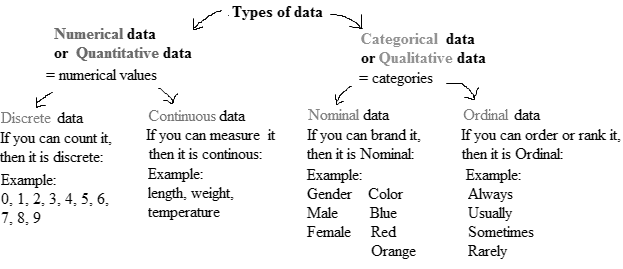
The values are classified into categories in a nominal variable, but no natural ordering is there in categories, whereas, the values are also classified into categories in an ordinary variablebut a natural ordering is there in categories.
Thus, to given question the choices for response has natural ordering with strongly oppose which indicating negative opinion and favor stating intensely positive feedback is ordinal variable.
Therefore, responses to given question are ordinal.
b.
To identify:Whether Jason’s answer reflects more of something.
Answer to Problem 49E
Jason’s answer reflects that he is favor of constructing a new shopping mall unlike Brenda
Explanation of Solution
Given information: A survey is administered by a marketing firm. Two of the people surveyed are Brenda and Jason. Three of the questions are as follows:
i. Do you favor the construction of a new shopping mall?
(1) Strongly oppose (2) Somewhat oppose (3) Neutral (4) Somewhat favor (5) Strongly favor
ii. How many cars do you own?
iii. What is your marital status?
(1) Married (2) Single (3) Divorced (4) Domestically partnered (5) Other
On question (i), Brenda answers (2) and Jason answers (4). Jason’s answer (4) is greater than Brenda’s answer (2).
Concept Involved:
There are various methods of collecting information by sampling. Once the information has been collected, the collection is called a data set. Variables can be divided into two types: qualitative and quantitative. Qualitative variables are also called categorical variable, classify individuals into categories. Quantitative variables are numerical and tell how much of something there is.
Qualitative variables come in two types: ordinal variables and nominal variables.
Ordinal variables are qualitative variables whose categories have a natural ordering.
Nominal variables are qualitative variables whose categories have no natural ordering.
Quantitative variables can be either discrete or continuous.
Discrete variables are those whose possible values can be listed. Often, discrete variables result from counting something, so the possible values of the variable are 0, 1, 2 and so forth.
Continuous variables can, in principle, take on any value within some interval.
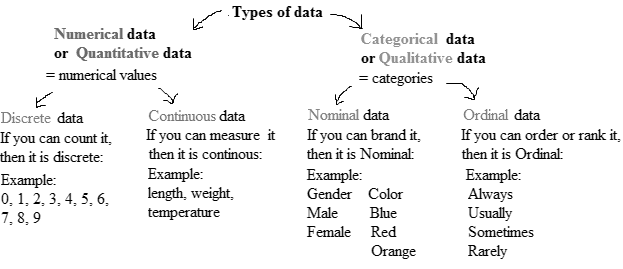
It is given that Brenda answered 2 and Jason answered 4. Thus Jason’s answer reflect more of positivity, as he though not sure of intensity of favoring the construction supported it, unlike Brenda.
c.
To identify:Whether Jason’s answer reflects twice as much of something.
Answer to Problem 49E
The variable response to given question is categorical in nature, so it doesn’t not imply Jason’s answer to given question is twice as much of something
Explanation of Solution
Given information: A survey is administered by a marketing firm. Two of the people surveyed are Brenda and Jason. Three of the questions are as follows:
i. Do you favor the construction of a new shopping mall?
(1) Strongly oppose (2) Somewhat oppose (3) Neutral (4) Somewhat favor (5) Strongly favor
ii. How many cars do you own?
iii. What is your marital status?
(1) Married (2) Single (3) Divorced (4) Domestically partnered (5) Other
Jason’s answer to question (i) is twice as large as Brenda’s answer.
Concept Involved:
There are various methods of collecting information by sampling. Once the information has been collected, the collection is called a data set. Variables can be divided into two types: qualitative and quantitative. Qualitative variables are also called categorical variable, classify individuals into categories. Quantitative variables are numerical and tell how much of something there is.
Qualitative variables come in two types: ordinal variables and nominal variables.
Ordinal variables are qualitative variables whose categories have a natural ordering.
Nominal variables are qualitative variables whose categories have no natural ordering.
Quantitative variables can be either discrete or continuous.
Discrete variables are those whose possible values can be listed. Often, discrete variables result from counting something, so the possible values of the variable are 0, 1, 2 and so forth.
Continuous variables can, in principle, take on any value within some interval.
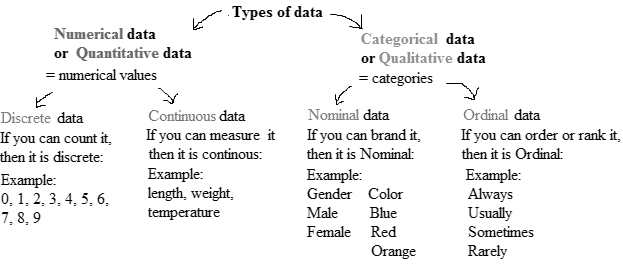
It is given that Brenda answered 2 and Jason answered 4. Thus Jason’s answer reflect more of positivity, as he though not sure of intensity of favoring the construction supported it, unlike Brenda. It is given Jason’s answer to given question is twice as large as Brenda, which does not implies twice as much of something, because, the variable response to given question is categorical in nature.
d.
To identify:Whether question (ii) qualitative or quantitative.
Answer to Problem 49E
The responses for question (ii): quantitative
Explanation of Solution
Given information: A survey is administered by a marketing firm. Two of the people surveyed are Brenda and Jason. Three of the questions are as follows:
i. Do you favor the construction of a new shopping mall?
(1) Strongly oppose (2) Somewhat oppose (3) Neutral (4) Somewhat favor (5) Strongly favor
ii. How many cars do you own?
iii. What is your marital status?
(1) Married (2) Single (3) Divorced (4) Domestically partnered (5) Other
Concept Involved:
There are various methods of collecting information by sampling. Once the information has been collected, the collection is called a data set. Variables can be divided into two types: qualitative and quantitative. Qualitative variables are also called categorical variable, classify individuals into categories. Quantitative variables are numerical and tell how much of something there is.
Qualitative variables come in two types: ordinal variables and nominal variables.
Ordinal variables are qualitative variables whose categories have a natural ordering.
Nominal variables are qualitative variables whose categories have no natural ordering.
Quantitative variables can be either discrete or continuous.
Discrete variables are those whose possible values can be listed. Often, discrete variables result from counting something, so the possible values of the variable are 0, 1, 2 and so forth.
Continuous variables can, in principle, take on any value within some interval.
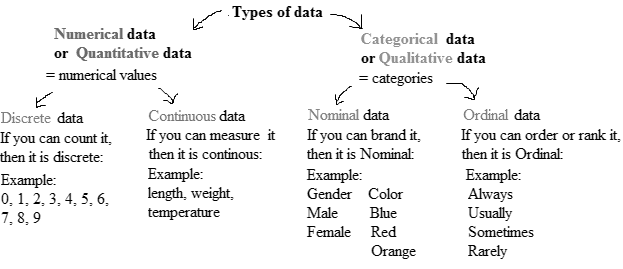
The variable which classifies individuals into categories is called qualitative variable, and the variable whichprovide information aboutquantity or number of something is quantitative variable. The variable number of cars owned by one tells how many cars one had been capable of possessing.
Therefore, the response is quantitative in nature.
e.
To identify:Whether Brenda’s answer reflect more of something and does it reflect Brenda’s answer is twice as much as something.
Answer to Problem 49E
The response is quantitative, Brenda’s answer reflect that she have more cars than Jason.
Yes! Brenda’s answer reflect that she have twice as many cars as what Jason have.
Explanation of Solution
Given information: A survey is administered by a marketing firm. Two of the people surveyed are Brenda and Jason. Three of the questions are as follows:
i. Do you favor the construction of a new shopping mall?
(1) Strongly oppose (2) Somewhat oppose (3) Neutral (4) Somewhat favor (5) Strongly favor
ii. How many cars do you own?
iii. What is your marital status?
(1) Married (2) Single (3) Divorced (4) Domestically partnered (5) Other
On question (ii), Brenda answers 2 and Jason answers 1.
Concept Involved:
There are various methods of collecting information by sampling. Once the information has been collected, the collection is called a data set. Variables can be divided into two types: qualitative and quantitative. Qualitative variables are also called categorical variable, classify individuals into categories. Quantitative variables are numerical and tell how much of something there is.
Qualitative variables come in two types: ordinal variables and nominal variables.
Ordinal variables are qualitative variables whose categories have a natural ordering.
Nominal variables are qualitative variables whose categories have no natural ordering.
Quantitative variables can be either discrete or continuous.
Discrete variables are those whose possible values can be listed. Often, discrete variables result from counting something, so the possible values of the variable are 0, 1, 2 and so forth.
Continuous variables can, in principle, take on any value within some interval.
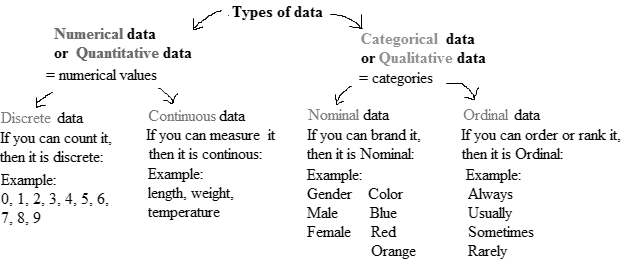
It is given that Brenda answered 2 and Jason answered 1 in response to given question, which clearly implies Brenda owns more cars than Jason. Brenda’s answer reflects twice as much as cars than Jason.
f.
To identify:Whether the responses to question (iii) nominal or ordinal.
Answer to Problem 49E
The responses to question (iii): nominal.
Explanation of Solution
Given information: A survey is administered by a marketing firm. Two of the people surveyed are Brenda and Jason. Three of the questions are as follows:
i. Do you favor the construction of a new shopping mall?
(1) Strongly oppose (2) Somewhat oppose (3) Neutral (4) Somewhat favor (5) Strongly favor
ii. How many cars do you own?
iii. What is your marital status?
(1) Married (2) Single (3) Divorced (4) Domestically partnered (5) Other
Concept Involved:
There are various methods of collecting information by sampling. Once the information has been collected, the collection is called a data set. Variables can be divided into two types: qualitative and quantitative. Qualitative variables are also called categorical variable, classify individuals into categories. Quantitative variables are numerical and tell how much of something there is.
Qualitative variables come in two types: ordinal variables and nominal variables.
Ordinal variables are qualitative variables whose categories have a natural ordering.
Nominal variables are qualitative variables whose categories have no natural ordering.
Quantitative variables can be either discrete or continuous.
Discrete variables are those whose possible values can be listed. Often, discrete variables result from counting something, so the possible values of the variable are 0, 1, 2 and so forth.
Continuous variables can, in principle, take on any value within some interval.
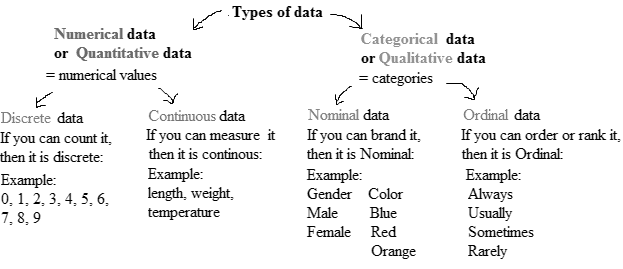
The values are classified into categories in a nominal variable, but no natural ordering is there in categories, whereas, the values are also classified into categories in an ordinary variable but a natural ordering is there in categories.
Thus, the responses to given question classifies one’s marital status into five categories.
Therefore, responses to given question are nominal.
g.
To identify:Whether Brenda’s answers reflect more of something and reflect twice as much as something.
Answer to Problem 49E
Brenda’s response of 4 and Jason’s response of 2 do not reflect more of something. Brenda’s answer does not reflect twice as much as Jason’s.
Explanation of Solution
Given information: A survey is administered by a marketing firm. Two of the people surveyed are Brenda and Jason. Three of the questions are as follows:
i. Do you favor the construction of a new shopping mall?
(1) Strongly oppose (2) Somewhat oppose (3) Neutral (4) Somewhat favor (5) Strongly favor
ii. How many cars do you own?
iii. What is your marital status?
- Married (2) Single (3) Divorced (4) Domestically partnered (5) Other On question (iii), Brenda answers (4) and Jason answers (2).
Concept Involved:
There are various methods of collecting information by sampling. Once the information has been collected, the collection is called a data set. Variables can be divided into two types: qualitative and quantitative. Qualitative variables are also called categorical variable, classify individuals into categories. Quantitative variables are numerical and tell how much of something there is.
Qualitative variables come in two types: ordinal variables and nominal variables.
Ordinal variables are qualitative variables whose categories have a natural ordering.
Nominal variables are qualitative variables whose categories have no natural ordering.
Quantitative variables can be either discrete or continuous.
Discrete variables are those whose possible values can be listed. Often, discrete variables result from counting something, so the possible values of the variable are 0, 1, 2 and so forth.
Continuous variables can, in principle, take on any value within some interval.
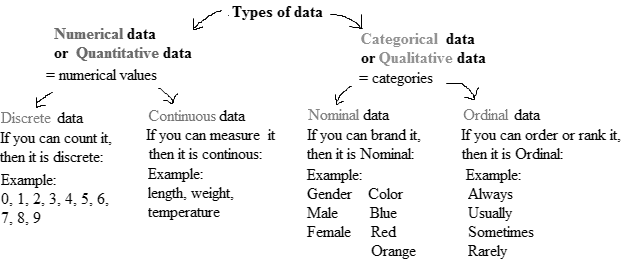
The values are classified into categories in a nominal variable, but no natural ordering is there in categories, whereas, the values are also classified into categories in an ordinary variable but a natural ordering is there in categories.
Thus, the responses to given question classifies one’s marital status into five categories.
Response to Marital status are nominal in nature, thus primarily the variable marital status is categorical. Hence, Brenda’s response of 4 and Jason’s response of 2 do not reflect more of something.
Therefore, Brenda’s answer does not reflect twice as much as Jason’s
Want to see more full solutions like this?
Chapter 1 Solutions
ELEM.STATS>LL<W/CONNECT-FD
- Apply STATA commands & submit the output for each question only when indicated below i. Generate the log of birthweight and family income of children. Name these new variables Ibwght & Ifaminc. Include the output of this code. ii. Apply the command sum with the detail option to the variable faminc. Note: you should find the 25th percentile value, the 50th percentile and the 75th percentile value of faminc from the output - you will need it to answer the next question Include the output of this code. iii. iv. Use the output from part ii of this question to Generate a variable called "high_faminc" that takes a value 1 if faminc is less than or equal to the 25th percentile, it takes the value 2 if faminc is greater than 25th percentile but less than or equal to the 50th percentile, it takes the value 3 if faminc is greater than 50th percentile but less than or equal to the 75th percentile, it takes the value 4 if faminc is greater than the 75th percentile. Include the outcome of this code…arrow_forwardsolve this on paperarrow_forwardApply STATA commands & submit the output for each question only when indicated below i. Apply the command egen to create a variable called "wyd" which is the rowtotal function on variables bwght & faminc. ii. Apply the list command for the first 10 observations to show that the code in part i worked. Include the outcome of this code iii. Apply the egen command to create a new variable called "bwghtsum" using the sum function on variable bwght by the variable high_faminc (Note: need to apply the bysort' statement) iv. Apply the "by high_faminc" statement to find the V. descriptive statistics of bwght and bwghtsum Include the output of this code. Why is there a difference between the standard deviations of bwght and bwghtsum from part iv of this question?arrow_forward
- According to a health information website, the distribution of adults’ diastolic blood pressure (in millimeters of mercury, mmHg) can be modeled by a normal distribution with mean 70 mmHg and standard deviation 20 mmHg. b. Above what diastolic pressure would classify someone in the highest 1% of blood pressures? Show all calculations used.arrow_forwardWrite STATA codes which will generate the outcomes in the questions & submit the output for each question only when indicated below i. ii. iii. iv. V. Write a code which will allow STATA to go to your favorite folder to access your files. Load the birthweight1.dta dataset from your favorite folder and save it under a different filename to protect data integrity. Call the new dataset babywt.dta (make sure to use the replace option). Verify that it contains 2,998 observations and 8 variables. Include the output of this code. Are there missing observations for variable(s) for the variables called bwght, faminc, cigs? How would you know? (You may use more than one code to show your answer(s)) Include the output of your code (s). Write the definitions of these variables: bwght, faminc, male, white, motheduc,cigs; which of these variables are categorical? [Hint: use the labels of the variables & the browse command] Who is this dataset about? Who can use this dataset to answer what kind of…arrow_forwardApply STATA commands & submit the output for each question only when indicated below İ. ii. iii. iv. V. Apply the command summarize on variables bwght and faminc. What is the average birthweight of babies and family income of the respondents? Include the output of this code. Apply the tab command on the variable called male. How many of the babies and what share of babies are male? Include the output of this code. Find the summary statistics (i.e. use the sum command) of the variables bwght and faminc if the babies are white. Include the output of this code. Find the summary statistics (i.e. use the sum command) of the variables bwght and faminc if the babies are male but not white. Include the output of this code. Using your answers to previous subparts of this question: What is the difference between the average birthweight of a baby who is male and a baby who is male but not white? What can you say anything about the difference in family income of the babies that are male and male…arrow_forward
- A public health researcher is studying the impacts of nudge marketing techniques on shoppers vegetablesarrow_forwardThe director of admissions at Kinzua University in Nova Scotia estimated the distribution of student admissions for the fall semester on the basis of past experience. Admissions Probability 1,100 0.5 1,400 0.4 1,300 0.1 Click here for the Excel Data File Required: What is the expected number of admissions for the fall semester? Compute the variance and the standard deviation of the number of admissions. Note: Round your standard deviation to 2 decimal places.arrow_forwardA pollster randomly selected four of 10 available people. Required: How many different groups of 4 are possible? What is the probability that a person is a member of a group? Note: Round your answer to 3 decimal places.arrow_forward
- Wind Mountain is an archaeological study area located in southwestern New Mexico. Potsherds are broken pieces of prehistoric Native American clay vessels. One type of painted ceramic vessel is called Mimbres classic black-on-white. At three different sites the number of such sherds was counted in local dwelling excavations. Test given. Site I Site II Site III 63 19 60 43 34 21 23 49 51 48 11 15 16 46 26 20 31 Find .arrow_forwardRothamsted Experimental Station (England) has studied wheat production since 1852. Each year many small plots of equal size but different soil/fertilizer conditions are planted with wheat. At the end of the growing season, the yield (in pounds) of the wheat on the plot is measured. Suppose for a random sample of years, one plot gave the following annual wheat production (in pounds): 4.46 4.21 4.40 4.81 2.81 2.90 4.93 3.54 4.16 4.48 3.26 4.74 4.97 4.02 4.91 2.59 Use a calculator to verify that the sample variance for this plot is . Another random sample of years for a second plot gave the following annual wheat production (in pounds): 3.89 3.81 3.95 4.07 4.01 3.73 4.02 3.78 3.72 3.96 3.62 3.76 4.02 3.73 3.94 4.03 Use a calculator to verify that the sample variance for this plot is . Suppose that we test the claim using that the population variance of annual wheat production for the first plot is larger…arrow_forwardIt is thought that prehistoric Native Americans did not take their best tools, pottery, and household items when they visited higher elevations for their summer camps. It is hypothesized that archaeological sites tend to lose their cultural identity and specific cultural affiliation as the elevation of the site increases. Let x be the elevation (in thousands of feet) for an archaeological site in the southwestern United States. Let y be the percentage of unidentified artifacts (no specific cultural affiliation) at a given elevation. Suppose that the following data were obtained for a collection of archaeological sites in New Mexico: x 5.50 6.00 6.75 7.00 7.75 y 37 38 92 70 99 Find the equation of the least squares line . Round a and b to three decimal places.arrow_forward
 Big Ideas Math A Bridge To Success Algebra 1: Stu...AlgebraISBN:9781680331141Author:HOUGHTON MIFFLIN HARCOURTPublisher:Houghton Mifflin Harcourt
Big Ideas Math A Bridge To Success Algebra 1: Stu...AlgebraISBN:9781680331141Author:HOUGHTON MIFFLIN HARCOURTPublisher:Houghton Mifflin Harcourt Holt Mcdougal Larson Pre-algebra: Student Edition...AlgebraISBN:9780547587776Author:HOLT MCDOUGALPublisher:HOLT MCDOUGAL
Holt Mcdougal Larson Pre-algebra: Student Edition...AlgebraISBN:9780547587776Author:HOLT MCDOUGALPublisher:HOLT MCDOUGAL Glencoe Algebra 1, Student Edition, 9780079039897...AlgebraISBN:9780079039897Author:CarterPublisher:McGraw Hill
Glencoe Algebra 1, Student Edition, 9780079039897...AlgebraISBN:9780079039897Author:CarterPublisher:McGraw Hill Functions and Change: A Modeling Approach to Coll...AlgebraISBN:9781337111348Author:Bruce Crauder, Benny Evans, Alan NoellPublisher:Cengage Learning
Functions and Change: A Modeling Approach to Coll...AlgebraISBN:9781337111348Author:Bruce Crauder, Benny Evans, Alan NoellPublisher:Cengage Learning Algebra and Trigonometry (MindTap Course List)AlgebraISBN:9781305071742Author:James Stewart, Lothar Redlin, Saleem WatsonPublisher:Cengage Learning
Algebra and Trigonometry (MindTap Course List)AlgebraISBN:9781305071742Author:James Stewart, Lothar Redlin, Saleem WatsonPublisher:Cengage Learning Algebra: Structure And Method, Book 1AlgebraISBN:9780395977224Author:Richard G. Brown, Mary P. Dolciani, Robert H. Sorgenfrey, William L. ColePublisher:McDougal Littell
Algebra: Structure And Method, Book 1AlgebraISBN:9780395977224Author:Richard G. Brown, Mary P. Dolciani, Robert H. Sorgenfrey, William L. ColePublisher:McDougal Littell





